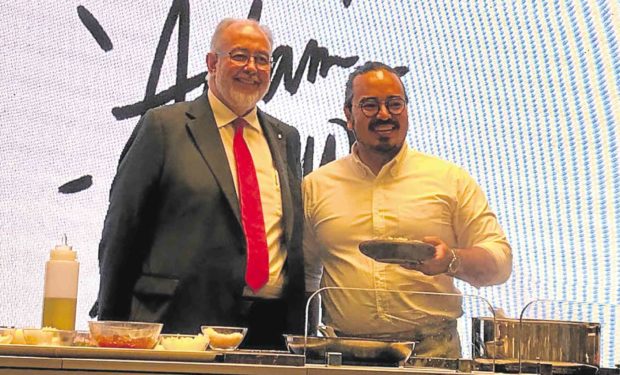
Cooking is not about changing flavors. It’s about preserving the flavors,” said Adam Liaw, 2010 winner of “MasterChef Australia.”
Author of six cookbooks, a columnist for Nine/Fairfax’s “Sunday Life,” and host of the award-winning SBS TV series “Destination Flavour,” Liaw favors approachable, simple and family-friendly recipes.
Born in Malaysia to an English-Singaporean mother and a Hainanese Chinese father, he lived in several countries before settling down in Australia. While he has a law degree and once practiced it, he has focused on cooking since competing in “MasterChef” in 2009.
Liaw was in Manila recently to do cooking demonstrations in line with this year’s “Taste of Australia.” Held in late April, the festival was a celebration of Australia’s culinary culture and products. Ranging from wines, olive oil and chocolates to cheeses, fresh fruits and milk, Australian products come from a land rich in natural resources and clean air.
“Australian fine food and produce reflect the pristine environment and high standards of food safety in Australia,” said Australia Ambassador Steve J. Robinson AO. “We’re delighted to share Australian food and coffee culture at this festival.”
No. 1 beef supplier
Australia’s early relations with the Philippines can be traced to food, Robinson added. In the early 1900s, Philippine sugar and coffee were sold to Australia through Queensland. Today, Australia is the No. 1 supplier of beef to the Philippines.
With brands such as Nature’s Harvest, MasterFoods, Norco, San Remo, Dolmio, Cobram Estate, John West, Breville and Harvest Box, Australian products are widely available in local supermarkets and specialty shops.
During the media event held recently at the Hilton Hotel in Resorts World Manila, executive chef Dennis Leslie prepared a tantalizing array of Australian dishes. A whole leg of lamb dominated a buffet table that groaned with typical Australian dishes such as meat pie, lamingtons and mini pavlovas. Cheeses, grapes, wines and nuts were also served.
Use a heavy pan
For his cooking demonstration, Liaw prepared steak and pasta.
“There are a lot of variations in cooking steak,” he said. “You can get 25 different answers on how to cook steak.”
His own method looked quick and easy. The important thing, he pointed out, is to use a heavy pan so the steak cooks evenly and doesn’t burn. Likewise, make sure the pan is hot enough before you put in the steak, so it doesn’t stick to the pan.
In addition, the steak should be at room temperature before cooking, said Liaw. After it has been cooked, let the steak rest several minutes before slicing it. That way, the juices of the meat will be preserved.
Here’s my recreation of Liaw’s recipe for steak and pasta.
Steak on Pasta
For the pasta:
4 c water
250 g San Remo pasta (about half of a 500-g package)
For the steak:
2 tbsp cooking oil
1 large Australian steak (sirloin, cube roll or strip loin)
Salt and pepper
2 tbsp butter
½ onion, diced
½ clove garlic, diced
2-3 tbsp red or white wine
¼ c beef stock
1 tsp thyme (optional)
3 tbsp heavy cream (optional)
Optional:
Shredded cheese
Basil or other desired herbs, cut into strips
Heat the water in a large casserole to boiling. When the water starts to boil, add the pasta. Cook, stirring the pasta occasionally, until the noodles are al dente (still firm to the bite).
Meanwhile, cook the steak. Heat the pan well. Add the cooking oil and heat the oil until very hot. Season the steak with salt and pepper. Put the steak in the hot oil. Cook, turning the steak occasionally, until it is of desired doneness (rare, medium-rare, well done).
Remove the steak from the pan and let rest about 10 minutes.
In the same pan, add the butter. Stir in the onion and garlic while scraping off the bits on the bottom of the pan (this is where the flavor is). Pour in the wine and beef stock. Add the thyme (optional) and heavy cream.
Taste the sauce and, if needed, season with additional salt and pepper. Let simmer, stirring and scraping the bottom of the pan continually, until the liquid thickens.
Transfer the pasta with a little of the pasta water to the pan. Stir so the noodles absorb the flavors of the sauce. Let simmer for one to two minutes.
Transfer the noodles to a serving dish. Slice the steak and serve on top of the pasta. If desired, sprinkle with cheese and herbs.
Makes two to three servings.